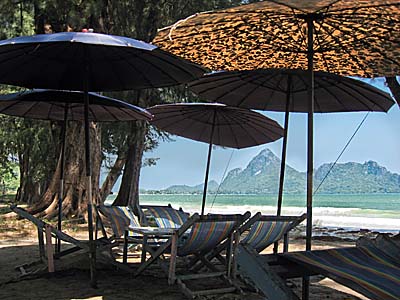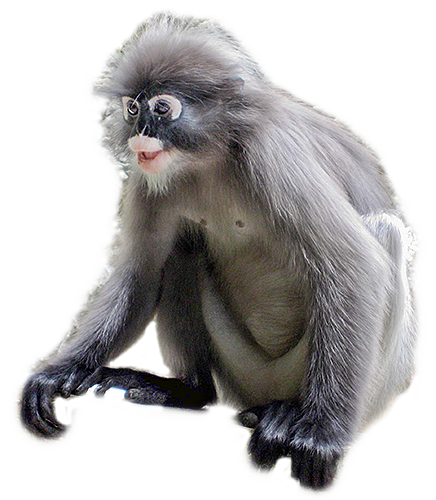
Prachuap
Prachuap Khiri Khan is a town and province capital on the Malay Peninsula at the Gulf of Thailand. The province of Prachuap Khiri Khan is named after the capital town and includes Bang Saphan in the south and Hua Hin in the north.
At the Pier of
Prachuap Khiri Khan
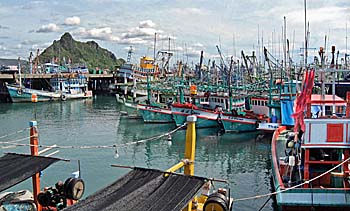
Fishing boats at the pier which is right in front of the town at the waterfront. They go out in the evenings, luring fish and other animals with strong lamps into their nets. After nightfall the horizon at the sea is dotted with spot lights. Image by Asienreisender, 2010
While the Isthmus of Kra in Ranong Province marks the narrowest point of the Malay Peninsula, a stretch near Prachuap Khiri Khan marks the narrowest point of Thailand's territory: Thailand is merely 11km wide here between the Gulf Coast and the border to Burma/Myanmar. The border between the two countries is marked by the peaks of the Tenasserim Mountain Chain.
The City Shrine
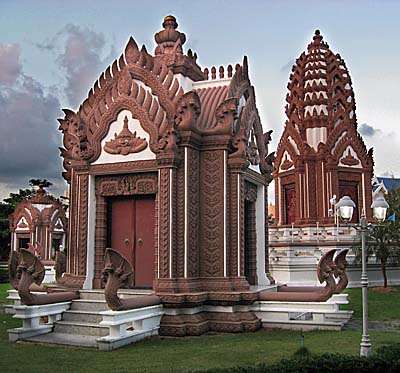
Prachuap Khiri Khan's Lak Mueng, the city shrine. Any Thai provincial capital has one, and it marks the center of the city and is a contribution for the spirits of the place. Prachuap has a remarkably large one, surrounded by four gate buildings. The architectonical style is clearly Angkorean, the shrine as the main building represents a prasat in reminiscence to those of Angkor Wat. Image by Asienreisender, 2006
Prachuap, as the place's short name is, has a climate which is classified as a tropical savannah climate. The distinctions between the seasons are not as clear as in most other regions of Thailand. In the dry season around July and August the weather is hot and dry and in 2010 there was over weeks a water shortage. The water supplies were cut over the day and only at night was tapped water available. A few kilometers west of town is an artificial, dammed lake in the mountains which serves as the water reservoir for Prachuap. A visit at the lake in the time of the drought showed a remarkable low level.
The two most rainy months are October and November, when the northwest monsoon comes over the Gulf of Thailand.
Prachuap is linked to Bangkok and Singapore by the peninsular railway line and the Phetkasem Road 4.
Prachuap Khiri Khan Railway Station
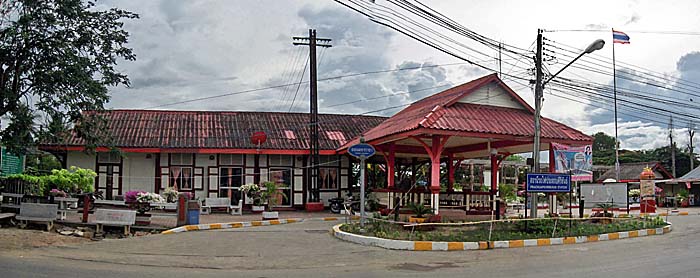
The railway station, built around 1900. All the Thai railway stations have their individuality. Picturesque are also the very small ones in the villages along the line. Image by Asienreisender, 2010
Bay and Inner City of Prachuap
The Bay of Prachuap Khiri Khan

All images by Asienreisender, 2006, 2010, 2015
Prachuap's Inner Town

All images by Asienreisender, 2006, 2010, 2015
The bay of Prachuap Khiri Khan is a long sand beach with a pier for the fishing boats. The bay is limited at the northern side by the mountain of Khao Chong Krachok. At the southern end of town the boulevard ends, but the beach continues into the airforce base. It's possible to walk along there, although the military want's any foreigner to register at a booth a few hundred meters inland. However, the bay comes to an end at the monkey mountain (with the dusky leaf monkeys). The first image shows the view one enjoys from the mountain to the north. The base with the main airstripe is to see, and behind lies the city of Prachuap Khiri Khan.
In the evenings there is a number of restaurants along the seaside boulevard who put chairs and tables on the sidewalk and serve food and drinks there.
The inner town of Prachuap is a typical Thai town. The images do reflect the atmosphere pretty good. It's not too busy, the place is widely clean and tidy. Traffic was still in limits. The place is lively in daytime around the market; in the evenings are the nightmarkets and the street vendors appearing and attracting guests.
Sigths of Prachuap Khiri Khan
A Macaque
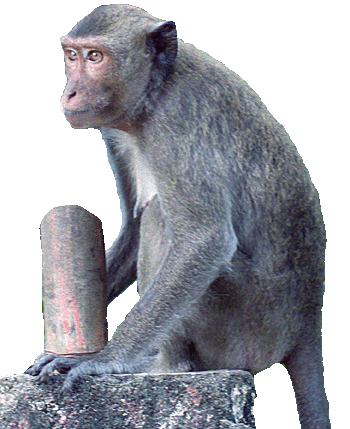
Khao Chong Krachok houses meanwhile a heavy overpopulation of macaques. Image by Asienreisender, 2006
At the northern edge of town lies Khao Chong Krachok (mirror mountain) who marks also the border of the bay of Prachuap. The mountain is overgrown with tropical vegetation. A stairway leads 396 steps upwards to the top. On the peak of 245m altitude is, as usually in Thailand, a small wat (temple) placed. The main wat to which it belongs is at the food of the mountain.
The mountain is dominated by several gangs of macaques, altogether several hundred monkeys. Thai People go there to feed them, for they believe that has a positive effect on their kharma or whatever. In fact it has the effect that the impudent monkeys grew a hefty overpopulation and started pesting the city. They enter the town, plunder dustbins, enter houses and kitchens where they steal food and cause damages and appear on the fresh market to take what they can get from the stalls. They are pretty aggressive and not easily to intimidate. Locals often use sticks or slingshots to keep them away from their places. Their population rose considerably in the four years from 2006 to 2010.
Walking up the stairway one forenoon in 2010, I found myself at half the way surrounded by a great number of the monkeys. Most of them were smaller ones, but a big alpha male was among them. They blocked the steps to and fro. No soul in sight. I decided better to turn back and managed slowly to pass by the beasts.
Such an experience I made already around Bukit Lawang in 1995, when a group of macaques tried to raid me in a rubber plantation and intended apparently to steal my bag. I could help myself by grabbing a (rotten) stick from the ground and to show them that I was armed. Another encounter happened on a mountain around Kaliurang in Java. The trouble with the beasts is the aggressivity and their ambition to steal things they hope there is food in. A bite of a macaque is a serious injury and needs quick treatment. Rabies is merely one of the possible infections. They have, by the way, impressive fangs.
The Gulf Coast at Prachuap
Seaside

All images and photocomposition by Asienreisender, 2006, 2010, 2015
Marine Life

All images and photocomposition by Asienreisender, 2006, 2015
The coastline of Prachuap is coined by long sand beaches in semi-circular shapes. It looks as there were once comets fallen down here who formed them; but that is not so. At the ends or beginnings of the beaches are steep and high limestone mountains. Most of them have a wat on top and it's possible to climb up, although it's not always possible without some climbing. A bit apart from the beaches are more limestone mountains who are characteristically steep, forested and full of caves. These mountains give the wildlife a last refuge, because it's difficult and dangerous to climb them.
One of the great attractions of Prachuap is the large aquarium some 10km south of town, directly at the seaside. A lot of bigger and smaller aquariums are displayed, and they house a lot of different species who live in the nearby Gulf of Thailand. There is a big aquarium with larger fish like the leopard sharks; it includes a tunnel where one is surrounded by water behind glass. The largest aquarium is a huge one over several levels, might be some eight meters high and five in diameter. Cone-shaped, with a large rock in the middle, it's inhabited by different kinds of fish and plants. The stars of this aquarium are the sharks, of who there were about ten adults around.
On the Airforce Base
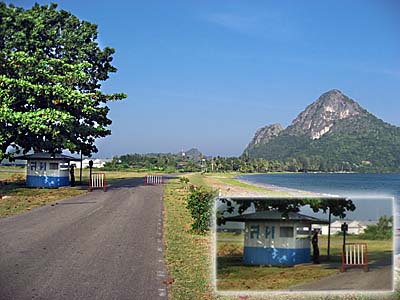
A military checkpoint on the airforce base. Image by Asienreisender, 2006
Directly south of Prachuap town lies a Thai airforce base, a large piece of land with some barracks. A few roads pass through the base. Usually locals can pass through without complications, while foreigners have to register at an office at the entrance. After coming back one has to take one off the list.
A long sand beach stretches there to the south and ends up at another mountain which is forested. Here lives a community of dusky leaf monkeys. On the very contrary to the macaques they are very nice and gentle animals. Some few locals sell monkey food as finger bananans or peanuts. One can give the monkeys the food with the hands and they will grab it without trying to bite or showing aggressive behaviour. The dusky leaf monkeys are langures and there lives a smaller group of them. Generally they live only on the Malay Peninsula. Here at this spot they are protected by the military, which maintains all the time two guard posts at the foot of the mountain.
Dusky Leaf Monkeys
Dusky Leaf Monkeys

Another of the great attractions around Prachuap is defenitely the group of dusky leaf monkeys at the rocky mountain at the airforce base. These langures are endemic on the Malay Peninsula only. The population consisted in 2006/2010 of mostly younger individuals, one baby and several juveniles. The babies have, by the way, a strong orange colour. One langure was clearly of advanced age.
Images and photocomposition by Asienreisender, 2006, 2015
It's possible to climb up the mountain. Partially there is a steep stairway, partially one has to climb over rocks. At some parts there are ropes to help the climber to come over steep and more difficult passages. On the mountain's top is again a small buddhist temple and the view reaches wide over the military base, the town of Prechuap Khiri Khan, to the Tenasserim Mountains and over the Gulf of Thailand.
On the large territory of the airbase is an annual international festival of volplane flights held. Another annual festival is the 'loi krathong', the 'floating light festival'. It falls in the fullmoon night of the 12th month of the old Siamese lunar calender. Small vessels of lotus are prepared and bedecked with candles. They are set out then on the sea in the bay of Ao Manao. More impressing are even the flying lanterns 'khom loi' who are sent into the sky. Loi krathong comes together with a beauty contest. A number of highly styled Thai girls take part in it.
Strange enough, but on the airbase is also a gulf course placed.
South of the military base lies Ao Manao, Lemmon Bay, a semi-circle of a bay with a long sand beach seamed with casuarina pine trees. Many foodstalls here offer food and drinks and one can squat here very comfortably in beach chairs. The whole bay has sandy grounds and walking into the water one can go pretty far out and still having ground under the feet, for the bay is not deep and lowering only slowly down.
Seaside
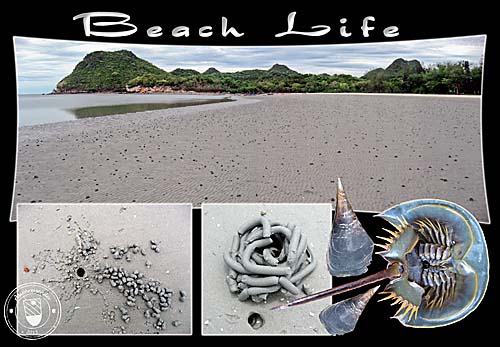
One of Prachuap's beaches at low tide. Crabs dig their holes into the sand, shells are around and the animal bottom right is a very archaic one. It's as a species certainly some hundreds of millions of years old. They are edible and appear on the fresh markets and in seafood restaurants. Images and collage by Asienreisender, 2006, 2010, 2015
Generally one gets great seafood in Prachuap's restaurants - it's of good quality, tasty and still inexpensive.
As any Thai town there is a daily nightmarket in the town's center near the fresh market. Many foodstalls offer good food in a great variety for little money.
In the mountains are some waterfalls of whome some are quite impressive, as Namtok Huai Yang, a nine-tiered waterfall close to the office of Huay Yang National Park. There are also some other national parks in Prachuap Khiri Khan Province. Despite the protection status the exploitation of the nature goes on in the parks. Khao Sam Roi Yot National Park for example is suffering heavy impact by shrimp farms, who use antibitotics in great amounts and pollute the surroundings considerably. And, of course, the wildlife is under growing pressure by poachers, because as rarer an animal of a certain species is, as higher is it's market value for all the many potential customers who are willing to pay for it.
Who is looking for nightlife has to go elsewhere. Prachuap is no place for extensive partying, neither are 'girlie bars' in the town.
The Thai/Burmese/Myanmar Border at Prachuap
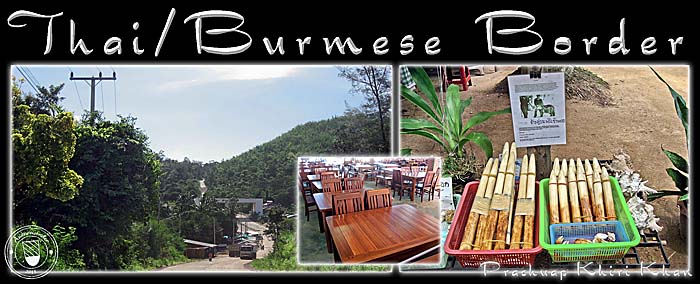
There is a mountain pass in Prachuap Province which leads through the Tenasserim Mountains (Dan Sing Khon). Meanwhile the road is paved and there is a certain border traffic established. On the Thai side of the border lies a hamlet with a relatively large market. Goods from Burma/Myanmar are sold here. Much of the stuff is furniture of good quality. But there is more. Thailand's poor neighbour is selling out it's natural resources like rare woods and endangered animal. I found ivory openly displayed on the market. It's certainly easy to get poached animals here as well.
Besides, after what I heared, there has been a new casino placed meanwhile on the Burmese side of the border. Wealthy Thai and Thai/Chinese or such who dream of becoming wealthy can go there now and try their luck. Gambling is probihited in Thailand itself. The owner of the casino is said is notorious Thaksin Shinawatra, former primeminister of and now persona non grata in Thailand.
Images and photocomposition by Asienreisender, 2010, 2015
Economy
The town of Prachuap Khiri Khan is by a great deal inhabited by Thai Chinese who are traditionally businessmen. The town is expanding and many condominiums have been built in the last years for Bangkokians who spent weekends or holidays here. The most significant economic sector here is agriculture, particularly fruits (above all there are huge pineapple fields around in the province), large coconut plantations and fishing.
Plantation Economy
Pineapple Plantations

A great deal of the land between the Gulf Coast and the mountains has been transformed into plantation economies. The largest share is pineapple, followed by other fruits. Coconut plantations are also many around, mostly closer to the seaside. Just a few years ago most of the land here has been tropical lowland rainforest.
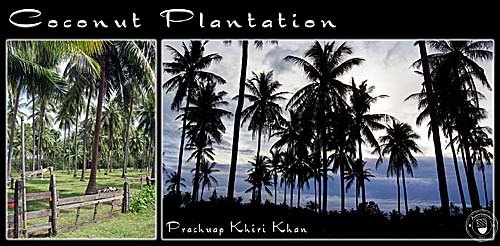
While the parts of the land who approach the mountains are widely used as pineapple plantations, the land close to the coast is dominated by coconut plantations. Images and photocomposition by Asienreisender, 2006, 2010, 2015
The beginning mountain scenery at the bottom of the slopes starts already to impress with huge rocks who are scattered around.
The plantations stop at the feet of the mountains, where the forest begins. But also here is the rainforest no more primary. All the slopes and hills look for secondary jungle - no big, old trees and rainforest giants anymore. I doubt, by the way, that it looks much better on the other side of the border. Business of all sizes always finds ways to cross borders. Besides, the Thai military is notorious for illegal logging activities, more and more beyond the Thai borders, after the old rainforests in Thailand have been cut mostly until the 1980s already.
The last image shows a quarry. It's one of the mountains who get cut into slices to gain larger stone blocks as well as smaller ones. It certainly serves to supply many building sites in Prachuap with material.
All images and photocomposition by Asienreisender, 2010, 2015
History
The former name of the place was Bang Nangrom or, alternatively Mueang Na Rong. The former town got destroyed by Burmese invaders in 1767, the same year of the conquest of Ayutthaya by a Burmese army and the complete destruction of the then Siamese capital.
The place was then abandoned over decades. It seems that in around 1845 there was a resettlement and reconstruction of the place, ordered by the Siamese king Rama III (reign 1824-1851). The rebuilt place got then the name Prachuap Khiri Khan.
The Battle of Prachuap Khiri Khan
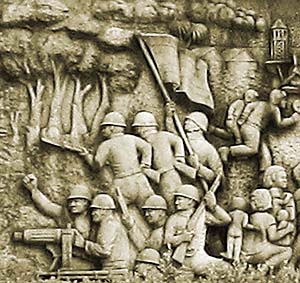
Part of the war memorial in Prachuap Khiri Khan. Image by Asienreisender, 2006
Similary with the attack on Pearl Harbour on Hawaii (USA) there was a series of Japanese attacks on eleven landing points in Thailand along the Gulf Coast. One of these invasion armies, the 143rd infantry regiment, landed at Ao Manao on December 8th, 1941. The Thai army reacted quickly and it came to bitter fighting here, until the Thai government negotiated a treaty with Japan and became an ally of Japan in the Second World War. The Japanese intention was, besides keeping whole Southeast Asia occupied as a colony for their empire, to attack the British in Malaya, Singapore and, in the west, in Burma to move towards India.
38 Thai airmen, police and civilians died in the fighting. 27 more were wounded. The Japanese lost 115 after their own accounts, while the Thai side estimates the Japanese losses at 217 dead and more than 300 wounded.
The historical event is celebrated annually here, and there is a war memorial in the airforce base.
The Battle Memorial in Prachuap Khiri Khan

War is misery. Always. However, it's getting all to often glorified. Image by Asienreisender, 2006
